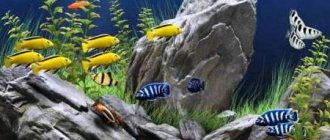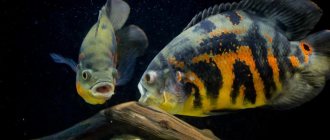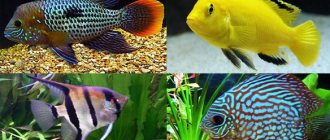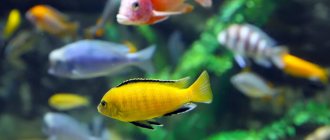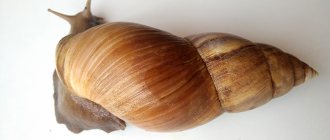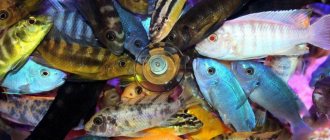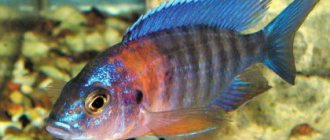— The fish of this group are very similar in behavior: they often “hang” in the water near walls and decorations. “This behavior in the aquarium is due to their behavior in the wild, where the fish hang out for a long time near rocks and stones. These are relatively peaceful and medium-sized cichlids.
- Products in stock
- Suitable plants and invertebrates
- Suitable feed
- Articles on the topic
- Video with Hemiancistrus
- Products to order
Most of these cichlids do not grow large. Their size ranges from 10-12 cm. The fish have very interesting behavior: some of them live at the bottom and build “nests” in shells, some stay vertically along the scenery, and some swim in the water column. The coloring of the cichlids of this group is not too bright and catchy, but that makes them no less charming! Fish can stay in a school or in pairs. Of course, they exhibit territoriality, but less so than other representatives of the cichlid family. Usually, a sufficient number of shelters in the aquarium helps to reduce aggression. Stones, grottoes, artificial and living plants are suitable for these purposes.
An aquarium for this group of fish may be of medium size (from 150 liters), but the larger the volume, the more natural it looks and the more comfortable the inhabitants feel. These cichlids look great in large aquariums (from 300-400 liters), designed to match the natural biotope of Tanganyika. Favorable water parameters in them: temperature +23…+26, hardness dGH up to 20, acidity pH 7-8.
Species aquarium
The water parameters at which cichlids will feel good in a home aquarium are poorly suited to other types of fish. Therefore, it is better to equip a species aquarium for them, creating an imitation of one of the biotypes of Lake Tanganyika.
Most often it is a soft sandy bottom with randomly located stones and structures made from them. It should be borne in mind that Tanganyika cichlids are very territorial fish. They will defend their shelter all the time, and not just during spawning. It is ideal to equip each pair of cichlids with a separate shelter at a short distance from the others. Although there is no guarantee that the fish will like the proposed options and they will not start digging their own caves.
Content
Malawian cichlids do not require special care, but they are still more often purchased by experienced aquarists, since they have the opportunity to create a biotope aquarium in which these African pets will live comfortably. The conditions of detention are as follows:
Aquarium. The most important thing is that it is spacious. The minimum volume is 150 liters. In such a “bank” you can only keep a couple of adults, given the size of Malawi cichlids. If you want to have a whole flock, then naturally you will need a larger container. The main thing is that at least 70-80 liters are allocated for one fish;
Water parameters. It should be taken into account that Malawian cichlids naturally live in an African lake, and accordingly, the water there is warm. The temperature in the aquarium must be maintained within 24-28 degrees. Acidity – 7.5-8.5 pH. The rigidity should be low, about 4-8°;
Equipment
To ensure that these cichlids do not get sick and keep their owner happy for a long time, it is important that they swim exclusively in clean water. Therefore, of course, weekly changes of at least a third of the total volume are required.
But, in addition, in order to minimize the content of ammonia, nitrates and phosphates, good filtration is necessary. Especially if you consider that these fish lead an active lifestyle and love to manage, digging up the soil. Because of this, it will not be possible to plant natural plants that would perform biological cleaning. Therefore, a standard internal filter will not be enough. You will need at least a bio or phytofilter, but it is best to buy an external type model, in which you can independently select the fillers, focusing on one or another type of cleaning. Well, and besides, without plants there will be no oxygen, which means the presence of a compressor is mandatory;
The minimum volume of the aquarium is 150 liters per pair of adults.
Decorations. You can use stones, shells and driftwood as decorations. From them you need to create various shelters, grottoes, caves, etc.
This is important for the fish themselves, since they lead a territorial lifestyle, as if sorting out where the “house” of each individual will be.
As for feeding, it directly depends on which Malawian cichlids were bred. If they are mbuna, then they need to be given food with herbal supplements, and sometimes it is advisable to even throw vegetables into the aquarium. Ducks prefer meat products, so they can be given rotifers, tubifex, brine shrimp, bloodworms, etc.
These fish are not too sensitive to diseases, but problems can still arise for various reasons. Most often, these pets are affected by Malawi disease. It manifests itself as a distended abdomen. Sometimes the scales may rise. The cause of the disease is the high content of nitrates, sodium chloride in the water, as well as poor nutrition and bacteria. There is no cure.
Description
Cichlids are divided into many species, differing from each other in size, body shape, color, and degree of aggressiveness towards other fish. All are united by belonging to the order Perciformes. The dorsal fins of Malawi fish are elongated and the rays are hard. The same applies to the anal fins. The color of the fish is very bright, the color palette is diverse.
Features of behavior
Malawian cichlids are active fish. They are constantly on the move, swimming around the entire aquarium, playing with each other, digging in the soil. They treat other fish that permanently live in the same territory with them with loyalty. Newcomers may be greeted aggressively and begin to chase them around the territory.
Newly acquired fish will most likely hide in hiding when they see a person. However, having gotten used to the new habitat, it soon begins to recognize the owner and, when he approaches the aquarium, swims towards him, begging for food.
Malawians are distinguished by their special attitude towards their offspring. Having laid eggs, fish carry them in their mouths, protecting them from enemies. The emerging fry can also hide in the throat pouch of their parents. In some species, only the female takes care of the babies, in others, both parents take care of them together.
Malawian cichlids
They live in a harsh and alkaline environment. They are divided into two groups - Utaka and Mbuna. Different representatives of each group can be kept in the same aquarium. Since all the fish have bright and varied colors, such aquariums are similar to sea aquariums.
Mbuna:
- Yellow cichlid, yellow cichlid, labidochromis, hummingbird cichlid is a yellow fish. Yellow cichlids look especially impressive if the back wall of the aquarium is a rich blue color
- Demasoni - cichlid with vertical dark blue and light blue stripes
- Melanochromis maingano, cichlid maingano - also dark blue and light blue stripes, but horizontal - from head to tail
- Yohani Cichlid - The males have a similar coloration to the Maingano, while the females are simply yellow-orange.
- The red zebra, zebra mbuna, is a cichlid that is bright orange fading to red.
- Pseudotropheus lombardo - in these cichlids the male is orange with pale vertical stripes in the dorsal fin area, and the female has black and blue stripes
- Melanochromis auratus, golden parrot, golden mbuna - a very aggressive fish, males are dark with yellow and blue stripes, and females, on the contrary, are yellow and have dark stripes
- Pseudotropheus pindani, pseudotropheus sokolov, blue pindani - blue cichlid with dark blue stripes on the fins
Utaka
Some species can be called peaceful cichlids, although they still remain predators:
- Haplochromis boazulu, protomelas boadzulu, cirtocara boadzulu, red empress cichlid, haplochromis red empress - the blue color of the head smoothly turns into an orange body with a dark stripe from the gills to the tail.
- Haplochromis kadango, Katanga cichlid, Opdichromis kodango - a fish with a blue head and a red body.
- Leopard cichlid, giraffe cichlid, Nimbochromis venustus - a fish with black spots on a yellow background and a blue head. Does not breed in captivity.
Compatibility with other types
Despite the fact that the frontosa is a large and predatory fish, it is very quiet, peaceful, calm and slow. But if you put small fish in the aquarium with it, it will destroy it . That is why, when choosing neighbors for this individual, you should give preference to large and leisurely species. The best option for keeping frontoses is a separate aquarium with up to 10 individuals.
It will be difficult for novice aquarists to create the right conditions for keeping frontosa. But for those with experience, it’s worth paying attention to the Queen of Tanganyika. It will be a wonderful decoration for the aquarium!
Various biotopes of Lake Tanganyika
By examining different biotopes in the lake, we can understand how cichlids mastered this or that niche.
Surf zone
Just a few meters from the shore can be considered the surf zone. Constant waves and currents create water here with a very high oxygen content, since carbon dioxide disappears instantly.
The so-called Gobi cichlids (Eretmodus cyanostictus, Spathodus erythrodon, Tanganicodus irsacae, Spathodus marlieri) or bull cichlids have adapted to life in the surf line, and this is the only place in Tanganyika where they can be found.
Rocky bottom
Rocky places can be of various types, from fist-sized stones to huge boulders several meters in size. In such places there is usually a very steep coast and the stones lie on other stones, not on the sand.
As a rule, sand washes onto stones and remains in crevices. Many cichlids dig nests in such crevices during spawning.
The lack of plants is compensated by the abundance of algae, which cover the stones and serve as food for many species of cichlids; in fact, fish that live mainly on fouling and feed.
This biotope is rich in fish with different behavior and habits. Both territorial and migratory species live here, cichlids living alone and in flocks, those that build a nest and those that carry eggs in their mouths.
The most widespread species are cichlids that feed on algae growing on rocks, but there are also plankton and predatory species.
Sandy bottom
Soil erosion and wind create a thin layer of sand at the bottom in some areas of Lake Tanganyika. As a rule, these are places with a relatively sloping bottom, where sand is carried by the wind or with rainwater.
In addition, in such places the bottom is abundantly covered with shells from dead snails. This is facilitated by the nature of the bottom and the parameters of the water, in which the disintegration of shells occurs rather slowly. In some areas of the bottom they form a continuous carpet. Many species of cichlids living in these places have adapted to live and spawn in these shells.
Typically, cichlids living in sandy biotopes are gregarious. After all, the best way to survive for fish that live in open places and are not large in size is to form a school.
Callochromis and Xenotilapia live in schools of hundreds of individuals and develop a strong hierarchy. Some, when in danger, immediately bury themselves in the sand. However, the body shape and coloring of these cichlids is so perfect that it is almost impossible to see them from above.
Muddy bottom
Something between a rocky and sandy bottom. Places where rotting algae residues accumulate and soil particles wash from the surface. As a rule, these are places where rivers and streams flow into the lake.
Silt serves as a food source for a variety of bacteria, and those, in turn, for various bioplankton. Although some of the plankton is eaten by cichlids, the bulk is eaten by various invertebrates, which also serve as food for the cichlids.
In general, places with muddy bottoms are atypical for Tanganyika, but they do occur and are distinguished by a variety of life.
Pelagic layer
The pelagic layer is actually the middle and upper layers of water. It is precisely these layers that account for the bulk of the water in Tanganyika; according to rough estimates, from 2.8 to 4 million tons of fish live in them.
The food chain here begins with phytoplankton, which serves as food for zooplankton, which in turn feeds fish. Most of the zooplankton is eaten by giant schools of small fish (not cichlids), which serve as food for predatory cichlids living in open water.
Benthos
The deepest, bottom and near-bottom layers in the lake. Considering the depth of Tanganyika, not a single river fish can survive in these places, since there is very little oxygen there. However, nature does not tolerate a vacuum and some cichlids have adapted to life in conditions of oxygen starvation and complete darkness.
Like bottom-dwelling sea fish, they have developed additional sensory organs and a very limited way of feeding.
Behavioral characteristics of the family Cichlidae
The behavior of these representatives of the underwater fauna is peculiar and attractive. Sociable and active by nature, cichlids are in constant motion, using the entire space of the aquarium.
Their activity increases in proportion to the increase in hunger. In pursuit of a portion of food, they organize real races and can instantly absorb everything that is offered to them, although such greed does not bring them any benefit.
Certain types of fish have highly developed hunting skills:
- nimbochromis, buried in the sand, pretend to be inanimate, thereby luring prey;
- Copadichromis, having a tube-shaped mouth, is able to easily suck in plankton like a vacuum pump.
The intelligence of cichlids is attractive to aquarists. They are able to recognize their owner and demonstrate unique social behavior.
Articles about cichlid fish on AquariumGuide.ru:
See the rules for caring for Managuan cichlasoma here.
With whom can you keep Cichlasama salvini fish?
Thus, almost all varieties of this family have developed parental care for their offspring. Cichlid aquarium fish carefully guard their clutches and care for the larvae and fry. Specifically, the Malawian species of fish hatch eggs in their mouths, and the hatched fry find refuge in the throat sac of their parents in a moment of danger. Therefore, with a relatively small number of eggs in these fish, their survival rate is quite high.
Description
Cichlids from Africa are majestic beauties whose special character and behavior have long captivated lovers. They have not only individuality, but also some intelligence: they are able to recognize the owner and, to some extent, become attached to him.
It is believed that the ancestors of African cichlids were marine fish - which is why among them you can find species that prefer brackish water. Today, this large group of fish occupies a significant part of Africa, living mainly in its eastern part. Their greatest diversity can be found in the Great Lakes of Malawi and Tanganyika, and some of the species have been caught as commercial fish for many years.
Lake Malawi is particularly densely populated by cichlids: about 800 species are already known, of which only 300 have been described. The water there is clear and clean, and the acidity is always stable. That is why aquarium species native to Malawi are demanding of these parameters.
The next most populated lake, Lake Tanganyika, is considered the second deepest in the world, and spreads over a huge area: more than 32 thousand square meters. km. For this it was even nicknamed “lake-sea”. The oxygenated waters of Taganyik are home to 250 species of cichlids, as well as 150 other species of fish. It can also boast that it was there that the smallest and largest cichlid fish in the world were found.
African cichlids can also be found in other lakes: Victoria, Kivu, Eduard, Rudolf, Albert, George, Nabugabo. But they inhabit not only standing water; some of the species are content with flowing water and live, for example, in the Congo River basin.
Cichlids from Africa are a very large group of fish, including representatives of very different appearances: most often the fish have an elongated body and a striking color. Most of them are carnivores, but there are also vegetarians. Depending on the species, African fish live in an aquarium from 5 to 18 years, and in natural conditions some species live up to 25.
Spawning
At the age of eight months, previously friendly schooling fish begin to break up into pairs and look for a place to hide. The largest dominant individuals are the first to occupy comfortable shelters, and the rest are content with what is left.
The fish carefully deepen the shelter, digging a hole in the soft sand. The spawning itself does not last long. The female lays eggs in the cavity, which are then fertilized by the male. And the fun begins.
Due to the fact that in nature cichlids did not have shelters in which to hide laid eggs and where the fry could then hide, the fish found another way out. After fertilization, the female carefully collects the eggs in her mouth and carries them there until the fry hatch. All this time she is not distracted even by food, so as not to lose her future offspring. A photo of a Tanganyika cichlid shows tiny fry swimming around the female.
And even small fish that are born first grow in the female’s mouth, swimming out only to feed. While the fry are placed in this living shelter, the female will protect them. Grown up small fish begin to feed on their own and hide from their adult relatives. Cichlids are predators, so they eat anything they can fit into their mouths.
Behavior of fish in an aquarium
When deciding to keep Tanganyika cichlids in a home aquarium, you need to know about the behavioral characteristics of these unusual fish.
Small species such as Julidochromis or Lamprologus callipterus will not cause much trouble to the owner. During spawning, fish can be aggressive, but the rest of the time they are quite peaceful. Of course, fights for territory usually cannot be avoided among cichlids, but they usually end with frayed fins and several torn off scales.
The larger the fish, the more aggressive and intolerant its behavior will be. For example, a pair of beautiful Cyphotilapia frontosa, about 30 cm in size, can keep all the other inhabitants of the aquarium at bay. A sufficient number of shelters and a decent size of neighbors who can fend for themselves will help.
Disease Prevention
Experienced aquarists claim that more than 90% of cichlid diseases described in the literature do not occur in practice. Although an important role in maintaining the health of pets is played by the desire to create ideal conditions for them. Therefore, an indispensable approach to maintaining any type is the following:
Prevention of fish diseases is the creation and maintenance of conditions that are vital for a given species. You should not allow even one fish to remain in a prolonged state of stress, as this is the first stage of illness or weakening of the immunity of all inhabitants of the aquarium.
You need to carefully monitor the condition of your pets and promptly place them in a separate “house” if necessary. This way you will save others.
Nutrition
The care and maintenance of Lake Tanganyika cichlids depends on the age of the fish, their type and size. Don’t be alarmed if the fish you bring home hide and don’t want to take food. They tolerate change very poorly and can adapt to a new aquarium for about a week.
While small fish are growing, they need to be fed several times a day. You can use frozen live food (bloodworms, brine shrimp, daphnia), since predatory fish treat them well. But be sure to add ready-made balanced food containing vitamins and herbal ingredients to the diet. Some species that naturally feed on algae simply need this. And large individuals will happily eat pre-thawed shrimp or squid cut into pieces.
Adult fish should be fed once a day, preferably in the evening and at approximately the same time. The fish quickly get used to it and after a couple of months they will begin to flicker at the front wall of the aquarium in the evenings, reminding the owner of dinner.
